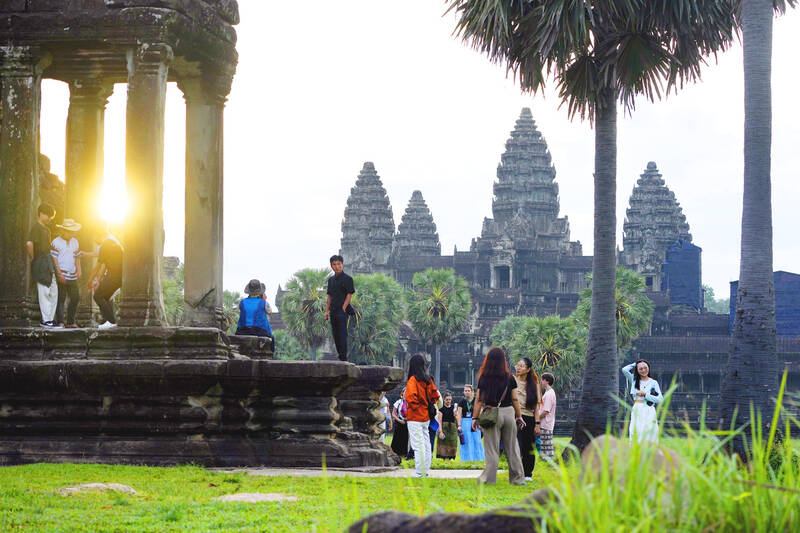One of the hottest viral trends, where people sprint, leap and crash around Cambodia’s historic Angkor Wat and other temple ruins in the Southeast Asian nation in a live recreation of a popular video game, has conservationists aghast, with several saying the race for views denigrates the almost 900-year-old sculptures and risks irreparable damage.
Short videos of visitors running down narrow stone pathways and vaulting over passageways — often overlayed with sounds from the popular Temple Run video game — have been making the rounds on TikTok, Facebook, YouTube and other platforms. Some videos have received more than 2 million views and inspire copycat versions daily.
Simon Warrack, a conservationist who has worked for three decades to preserve the nearly millenia-old ruins at Angkor, is troubled by the potential damage as well as the cultural and religious insensitivities being trampled on.

Photo: AP
“You wouldn’t run through St Peters in Rome or any Western church — so why is it okay to do it in Cambodia?” Warrack asked. “It’s not just potential damage to the stones by people bumping into them and falling or knocking things over — which is real — but it’s also damage to the spiritual and cultural value of the temples.”
Warrack said he has spoken to Cambodian counterparts and officials overseeing the complex who share his concerns.
“Angkor Wat is still deeply revered by the people,” he said. “Every stone is considered to contain the spirits of the ancestors.”
The episode highlights the challenge many historic sites face these days to balance increased tourism, sustainability and local life, particularly in a post-COVID-19 pandemic world where revenge travel is still a thing. The trend also underscores the sway influencers and social media have in driving tourism.
Cambodia is not the only destination to see an uptick in bad behavior, but whereas other hot spot tourist meccas including Indonesia and Spain have taken steps to tame unruly visitors — Indonesia deports the worst offenders — the authority that oversees the Angkor temple complex has not issued any reprimands to discourage the viral trend. International visitors to Cambodia have yet to return to pre-pandemic levels and even some Cambodians themselves have said on social media that the trend is good for boosting much needed arrival numbers.
For many holiday seekers, social media are a top source of inspiration for travel, according to an American Express trends report.
About three in four millennials and Gen Zers surveyed said they have participated in social media trends while on vacation, while around half said they want to show off their travels to impress their followers.
In the temple run challenge, many videos feature people in their 20s, some running in dresses and shawls. Angelina Dougherty, a Cambodian-American who was crowned Miss Pacific Asian American in a pageant last year, also joined the trend with a video of her and another woman running and leaping through the temple, similar to moves in the video game.
Doughtery did not respond to a request for comment.
Hollywood introduced Angkor Wat to much of the world when the 2001 movie Lara Croft: Tomb Raider was filmed at the complex’s Angkor Thom temple. Then came Temple Run, a video game developed by Imangi Studios in 2011, where players control a character who runs through temple ruins and must avoid obstacles and demonic creatures who give chase. The background for Temple Run features stonework and passageways that are very similar to the ruins at Angkor.
Angkor, which is on the UN World Heritage List and consists of more than 100 temples, is one of the most important archaeological sites in Southeast Asia. The ruins are a big economic driver for the predominantly rural country. Before the pandemic hit, the 162-hectare compound saw a record 6.6 million tourists who brought in more than US$80 million in ticket sales. So far this year, the ruins have attracted about 630,000 visitors.
The complex, which includes the famous temples of Angkor Wat and Angkor Thom, was constructed with blocks of sandstone and has survived war, earthquakes and forest overgrowth. Over the years, international conservators have contributed to the ongoing restoration efforts.
“While the trend has temporarily boosted online interest in Angkor, it’s essential to promote safe access, educational visitation and respect for local religious, spiritual and social significance of the sites,” said Ginevra Boatto, Cambodia director of the World Monuments Fund, which partners with local authorities in charge of sites to help protect them.
New visitor trends should be “carefully managed to prevent any negative impact,” Boatto said.
Some of the videos do feature caveats that the reenactments are done in appreciation of the temples. Most responses from viewers are positive, with many excited to be introduced to the temples through the challenge.
However, Hans Leisen, who has headed a German-government funded conservation project at Angkor Wat for 30 years, did not mince words in describing his reaction to the videos.
“It’s nonsense,” said Leisen, who has worked to preserve the temples’ delicate bas reliefs and carvings that tell religious stories.
“If you’re running through the temple, you won’t see the beauty of the carvings. And if you fall or stumble, you’ll touch a wall to stabilize yourself and endanger the fragile carvings,” Leisen said.
Leisen said he is concerned the trend could spread to other temple sites in Southeast Asia.
In Bali, Indonesia, the government last year created a tourism task force and hotline where locals can report bad behavior by tourists. Authorities recently updated their guidance for the island’s expected 14 million visitors this year, calling on them to observe local laws and customs, which include covering up at temples and respecting the sanctity of religious sites.
In Cambodia, the APSARA National Authority, the government agency that oversees the Angkor complex, issued a code of conduct for visitors at least eight years ago that prohibits touching carvings and leaning on temple structures. According to local media, the kingdom’s tourism minister has more recently expressed concern about potential damage to the ruins due to the viral trend.
APSARA declined to comment, while the tourism ministry did not respond to a request for comment.
Still, at least one Cambodian does not mind the viral challenge.
The Royal Academy of Cambodia policy analyst Seun Sam said the videos could help bring much needed tourism to Cambodia, which contributed 18 percent to gross domestic product in 2019. Tourism more generally in Cambodia is helping to drive the country’s expected economic growth of 5.8 percent this year, according to the Asian Development Bank.
“As long as they don’t damage the temples and bother other people, it’s okay,” said Seun, who added that in some videos, visitors are running on paths that serve as sidewalks.
“Tourism is very important for Cambodia’s economy. When foreign visitors come, they buy things, they spend on hotels and transport. We want to encourage that,” he said.

The DBS Foundation yesterday announced the launch of two flagship programs, “Silver Motion” and “Happier Caregiver, Healthier Seniors,” in partnership with CCILU Ltd, Hondao Senior Citizens’ Welfare Foundation and the Garden of Hope Foundation to help Taiwan face the challenges of a rapidly aging population. The foundation said it would invest S$4.91 million (US$3.8 million) over three years to foster inclusion and resilience in an aging society. “Aging may bring challenges, but it also brings opportunities. With many Asian markets rapidly becoming super-aged, the DBS Foundation is working with a regional ecosystem of like-minded partners across the private, public and people sectors

Taiwan Semiconductor Manufacturing Co (TSMC, 台積電) has secured three construction permits for its plan to build a state-of-the-art A14 wafer fab in Taichung, and is likely to start construction soon, the Central Taiwan Science Park Bureau said yesterday. Speaking with CNA, Wang Chun-chieh (王俊傑), deputy director general of the science park bureau, said the world’s largest contract chipmaker has received three construction permits — one to build a fab to roll out sophisticated chips, another to build a central utility plant to provide water and electricity for the facility and the other to build three office buildings. With the three permits, TSMC

BREAKTHROUGH TECH: Powertech expects its fan-out PLP system to become mainstream, saying it can offer three-times greater production throughput Chip packaging service provider Powertech Technology Inc (力成科技) plans to more than double its capital expenditures next year to more than NT$40 billion (US$1.31 billion) as demand for its new panel-level packaging (PLP) technology, primarily used in chips for artificial intelligence (AI) applications, has greatly exceeded what it can supply. A significant portion of the budget, about US$1 billion, would be earmarked for fan-out PLP technology, Powertech told investors yesterday. Its heavy investment in fan-out PLP technology over the past 10 years is expected to bear fruit in 2027 after the technology enters volume production, it said, adding that the tech would

YEAR-END BOOST: The holiday shopping season in the US and Europe, combined with rising demand for AI applications, is expected to drive exports to a new high, the NDC said Taiwan’s business climate monitor improved last month, transitioning from steady growth for the first time in five months, as robust global demand for artificial intelligence (AI) products and new iPhone shipments boosted exports and corporate sales, the National Development Council (NDC) said yesterday. The council uses a five-color system to measure the nation’s economic state, with “green” indicating steady growth, “red” suggesting a boom and “blue” reflecting a recession. “Yellow-red” and “yellow-blue” suggest a transition to a stronger or weaker condition. The total score of the monitor’s composite index rose to 35 points from a revised 31 in August, ending a four-month